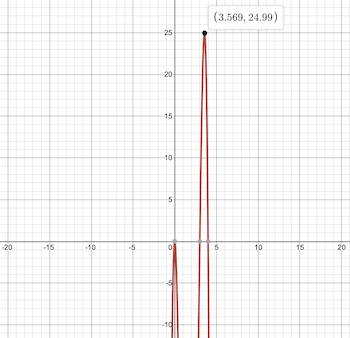[ f(x) = -x * 8 * x * (x - 3) * (x - 4) ]
Using the DEAP Framework to demonstrate the performance of One-plus-One algorithm and compare it with the baseline Random algorithm.
- Set the population size being equal to 1.
- Evaluate the population.
- Mutate the best individual.
- Evaluate the mutants.
- Compare the mutation with the best and select the individual with the highest fitness value.
- Repeat until reaching an exception.
- Set the population size being equal to 1.
- Evaluate the population.
- Generate a random individual as offspring from an original individual.
- Compare the offspring with the best and select the individual with the highest fitness value.
- Store the individual with the best fitness value
Execute the experiment in 12 epochs and see how the algorithm evolved.
fitness size
---------------------------------------- -------------------------------------------
gen evals min avg max avg evals gen max min std
0 0 -66.8118 -66.8118 -66.8118 1 0 0 1 1 0
1 1 -1.59792 -1.59792 -1.59792 1 1 1 1 1 0
2 2 -1.59792 -1.59792 -1.59792 1 2 2 1 1 0
3 3 -1.59792 -1.59792 -1.59792 1 3 3 1 1 0
4 4 -1.59792 -1.59792 -1.59792 1 4 4 1 1 0
5 5 -1.59792 -1.59792 -1.59792 1 5 5 1 1 0
6 6 -1.59792 -1.59792 -1.59792 1 6 6 1 1 0
7 7 -1.59792 -1.59792 -1.59792 1 7 7 1 1 0
8 8 -1.59792 -1.59792 -1.59792 1 8 8 1 1 0
9 9 24.922 24.922 24.922 1 9 9 1 1 0
10 10 24.922 24.922 24.922 1 10 10 1 1 0
11 11 24.922 24.922 24.922 1 11 11 1 1 0
12 12 24.922 24.922 24.922 1 12 12 1 1 0
fitness size
---------------------------------------- -------------------------------------------
gen evals min avg max avg evals gen max min std
0 0 -66.8118 -66.8118 -66.8118 1 0 0 1 1 0
1 1 -35.0343 -35.0343 -35.0343 1 1 1 1 1 0
2 2 -35.0343 -35.0343 -35.0343 1 2 2 1 1 0
3 3 -35.0343 -35.0343 -35.0343 1 3 3 1 1 0
4 4 23.7197 23.7197 23.7197 1 4 4 1 1 0
5 5 23.7197 23.7197 23.7197 1 5 5 1 1 0
6 6 23.7197 23.7197 23.7197 1 6 6 1 1 0
7 7 23.7197 23.7197 23.7197 1 7 7 1 1 0
8 8 23.7197 23.7197 23.7197 1 8 8 1 1 0
9 9 23.7197 23.7197 23.7197 1 9 9 1 1 0
10 10 23.7197 23.7197 23.7197 1 10 10 1 1 0
11 11 23.7197 23.7197 23.7197 1 11 11 1 1 0
12 12 23.7197 23.7197 23.7197 1 12 12 1 1 0
Compare the final result with the global maximum of the graph function to evaluate the algorithm performance.
Fig. 2: The global maximum of the given function

